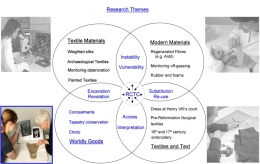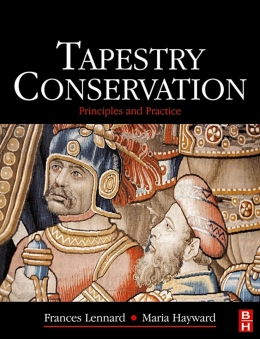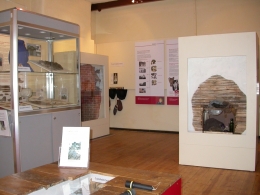Wordly Goods
This theme covered a wide range of research projects including:
- The conservation of tapestries. These are the large, decorative wall-hangings seen on open display in historic houses and museums. They were often made in sets of three or four, and are of fundamental importance to a room’s decorative scheme. Many are woven from cartoons painted by important artists, e.g. Raphael and more recently Lurçat and Henry Moore. Many were of great financial value when woven, often being much more highly valued than paintings by the same artists or studios. For example, in 1528 Henry VIII bought a 10-piece set of tapestries depicting the Story of David for £1,500.00, while in 1538 Holbein, the King’s painter, received £30.00 per annum paid quarterly. The most expensive tapestries are often woven with a high proportion of silk rather than wool, and contain silver and silver gilt threads.
- Conserving tapestries is problematic for many reasons, including: their large scale; their vulnerability to environmental factors (seen as colour fading, gaping slits, tears in silk areas and corrosion of exposed silver threads); the extent of previous, often amateur, repairs (both sewn and glued); the mechanical strain of being hung or stretched on open display for decades, and their dual role (as works of art and furnishings). It requires specialist skills to preserve both their design and functional properties; given their large scale and decorative importance, they are usually treated by teams of specialists, who may work for over one year on a single set. The costs of employing specialists to work on long projects are high. This helps to explain the importance given to preventive conservation, and to assessing the relative merits of different remedial treatments.
- Garments deliberately concealed in buildings. This research involved analysis of both the practice of concealment and the garments (and related finds), and the conservation problems they pose. Concealed objects include bottles, shoes and worn garments. Concealment caches have preserved rare examples of working dress, e.g. two doublets of c. 1600. These garments are always well-worn, and it appears that garments bearing the imprint of the wearer were often selected fogort concealment. They are often very creased and dirty, and are difficult to store and display. They also pose interesting ethical challenges, as regards the removal or retention of soiling and creasing, as the latter may be considered of evidential value. They are also evidence of a long-standing, 'superstitious' practice, which it is believed was intended to ward of evil forces Deliberately Concealed Garments Project.



